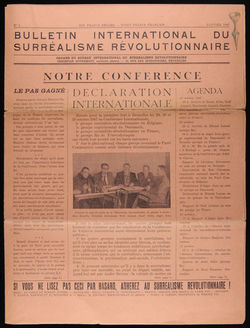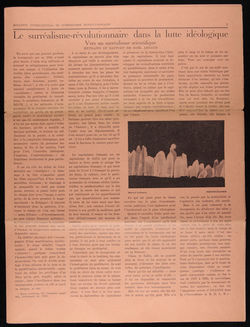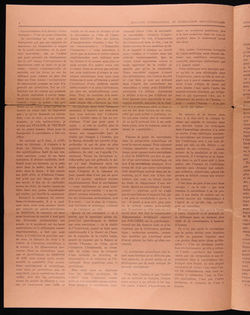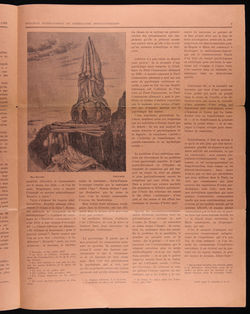Revolutionary Surrealism

Founded by the artist Christian Dotremont after the Second World War, Surréalisme révolutionaire (Revolutionary Surrealism), sought to reinvent Surrealism by merging revolutionary politics and art. Members of this group went on to be involved in CoBrA and the Situationist International.
Surrealisme Revolutionnaire Collection, 1943-49
Surrealisme Revolutionnaire Collection, 1943-49, drawn from the private collections of Noël Arnaud and Marcel Marië. Features corrrespondence, manuscripts, printed materials, artwork, meeting minutes, tracts, lectures, drawings, and other records documenting the efforts of artists and writers in Belgium, France, Denmark, and Czechoslovakia to reinvigorate the Surréalisme révolutionnaire movement of the late 1940s. The bulk of the material in the collection represents work by individuals affiliated with the Groupe surréaliste-révolutionnaire de Belgique and Groupe surréaliste-révolutionnaire en France, including Yves Battistini, Paul Bourgoignie, Christian Dotremont, Edouard Jaguer, Asger Jorn, René Magritte, and René Passeron. Printed materials include posters, clippings, and issues of the journals Les deux sours, founded by Christian Dotremont, and Le surrealisme révolutionnaire, published by the Bureau international du surréalisme révolutionnaire. Works of art include original drawings by Noël Arnaud and black-and-white photographs by Marc Vaux and Studio Yves Hervochon of artwork by Francis Bott, Jacques Doucet, Henri Goetz, Josef Istler, and Pierre Soulages.
Bulletin international du surréalisme révolutionnaire, 1948, Brussels, two copies; includes article on Danish surrealism.
Le surréalisme révolutionnaire, 1948, poster advertising the eponymous periodical.
Le surréalisme révolutionnaire, 1948/2008, facsimile reproduction of two issues of the journal.
Related collections
Revolutionary Surrealism
The year 1947 marked a period of national unity and political liberalism in the French Community Party. While Jean-Paul Sartre challenged Surrealism from a pro-Marxist perspective, a group of artists emerged who claimed to be at the forefront of Surrealism but who were also members of the French Community Party. The Revolutionary Surrealist group, headed by Christian Dotremont, was formed on May 17, 1947, in Brussels. Other inaugural members included Paul Bourgignie, Achille Chavóe, Marcel Havrenne, René Magritte, Marcel Mariën, Paul Nougé, and Louis Scutenaire. The group continued to espouse the key principals of André Breton's Surrealism, but wanted to join these aesthetic tactics with social and political strategies.
The International Conference of Revolutionary Surrealism was held in Brussels on October 29, 1947. Asger Jorn participated in the precedings, and became involved with the group. Within a year, however, the Revolutionary Surrealists made contact with the Dutch Experimental Group, based in Amsterdam, which was comprised of Karel Appel, Guillaume Corneille, and Constant and Jan Niewenhuys. On November 8, 1948, members of the two groups, including Karel Appel, Corneille, Dotremont, Jorn, Constant, and Joseph Noiret, met in Paris and signed a declaration titled "Cause était entendue" (The Case is Closed), giving birth to CoBrA.


p. 2

Resources
Pre-Situationist Chronology, which includes development of Revolutionary Surrealism.
"Surrealisme in België," by Willem Elias (in Belgian).
Le Surréalisme Révolutionnaire, by Karine Guihard, thesis, Université de Nantes (in French; pdf).











